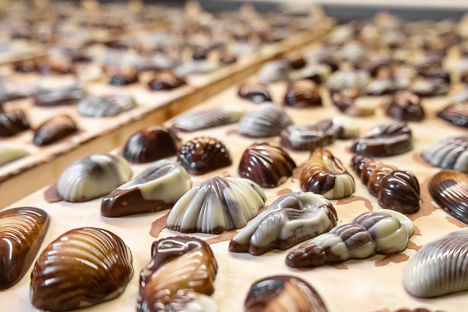
A brief history of Belgian chocolate
Rich, smooth and luxurious, Belgian chocolate is celebrated the world over. Starting at its seventeenth century roots, we look at what sets it apart and how its chocolatiers became so renowned.
A brief history of Belgian chocolate
Rich, smooth and luxurious, Belgian chocolate is celebrated the world over. Starting at its seventeenth century roots, we look at what sets it apart and how its chocolatiers became so renowned.
A city break to Belgium isn’t complete without an afternoon spent in its artisan chocolate shops, meeting its chocolatiers and emerging laden with treat-filled bags. But we don’t need to hop on a plane to satisfy our cravings – Belgian chocolate’s popularity around the world means the bars and boxes are easy to get hold of in shops and supermarkets here in the UK. Recognised around the world for its buttery smoothness and rich aroma – we have its generous levels of cocoa and cocoa butter to thank for that – Belgian chocolate has well and truly earned pride of place as one of the country’s most cherished exports. In fact, Belgium is said to produce around 600,000 tonnes of chocolate every year, and is home to more than 2,000 chocolate shops.
To trace Belgian chocolate’s history, we have to head back to the seventeenth century, when chocolate first arrived on Belgian shores thanks to Spanish travellers (Belgium at that time was under Spanish occupation) who brought beans back from South America in around 1635. At the time, chocolate was a sign of luxury, mainly enjoyed as hot chocolate among nobility (the mayor of Zurich is said to have been served a cup of it during a visit to Brussels’ Grand Palace in 1697). That was the case until the nineteenth century, when chocolate began to take different forms and became more widely available. This was thanks to both industrialisation, which made it easier to produce cocoa mass in bigger quantities, and the shift in sourcing cocoa beans from South America to West Africa, where Belgium had a colonial presence. These changes made upscaling chocolate production simpler, and chocolatiers soon began setting up factories across Belgium and wider Europe.
Though word had already started to spread, Belgian chocolate’s popularity was given a boost in 1912 by chocolatier Jean Neuhaus, whose grandson created the first praline – in its simplest form, a chocolate shell filled with a soft centre (the word praline is also used to describe sugared almonds from France) – and whose wife later invented the ballotin, a traditional gift box in which they were presented. Pralines soon became a hallmark of Belgian chocolate, and it was around this time that Belgian chocolate’s popularity began to soar. Over the following decades, several household name brands sprang into life – including Guylian. In 1958, Guy Foubert and his wife Liliane merged their names to create the brand, and began producing their own Belgian chocolates. Guylian’s iconic seashells were born a decade later, when the couple returned from a holiday on the Belgian coast keen to create a chocolate souvenir of their trip. Today, their marbled white, milk and dark chocolate seashells, filled with a rich hazelnut praline, are instantly recognisable. Its master chocolatiers make up to 75 tonnes of chocolate every day at its Sint-Niklaas factory (all chocolate labelled as Belgian must be refined and moulded in Belgium), turning it into bars, miniature pralines and seashells – we eat ninety-five million of the seashells every year in the UK alone – which are then sold in over 100 countries around the world.
Brands like Guylian ensured that Belgian chocolate’s popularity only continued to blossom throughout the late 1900s. Chocolate became synonymous with Belgium – as well as its countless shops (most villages across the country are home to one), there are also museums, tours and tastings dedicated to the craft. Today, chocolate-making in Belgium is a balance of tradition and innovation – chocolatiers, for example, are not only creating sweet treats in all sorts of shapes, sizes and flavours, but also protecting the planet and cocoa growing communities. Guylian is now the biggest Belgian A-brand which is certified as using 100% Fairtrade cocoa, ensuring better prices and work conditions for farmers and combating deforestation, and only uses natural ingredients. Many Belgian chocolate-makers have also signed up to The Beyond Chocolate Charter, which has challenged them to make chocolate using only sustainable cocoa by 2025 (Guylian achieved that in 2022). But while it has changed in some ways, Belgian chocolate-making is still led by tradition, with the features that set it apart protected. That includes its high cocoa content compared to other types, its use of 100% cocoa butter (rather than substituting with vegetable fats) and a fine bean grind, which gets rid of any graininess. When brought together, it’s this focus on quality that is responsible for Belgian chocolate’s wonderfully smooth, rich taste.
Belgian chocolate has come a long way since its early days and today, it is rightly recognised as amongst the finest in the world, rooted in tradition but driven forward by innovation.


